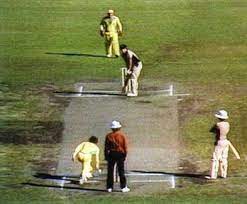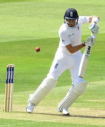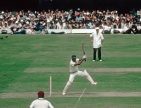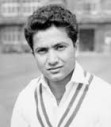Australian Odyssey: Greg Chappell and the 1980/81 Season
Gareth Bland |
Australia’s second dual home international summer in 1980/81 was a tumultuous one that set the scene for the upheaval that bedeviled the Australian team in the first half of that decade. The second Australian summer since the Packer realignment had irrevocably altered the country’s cricket schedules and saw tensions rise and players wilt under the new demands. Most prominent among these was the Australian captain himself, Greg Chappell, whose spectacular burnout reached its all too public peak under the full glare of a baking Melbourne sun in February 1981.
When Chappell decided the mind and body could take no more, he opted to skip the Ashes series in the 1981 English summer. The mythology of Botham’s Ashes also has an Australian side to the story, not least that of the man who would lead the Aussies in England, Kim Hughes. The preceding Australia summer of 1980-81 is the background to that England tour, how the Australians came to take the squad they did, and how competing factions would influence the outcome of an Ashes Test series which has long since entered English cricketing folk lore.
All this seemed some way off on the first day of September 1980 when the Centenary Test had just reached its conclusion. Following the drawn Test’s post-match ceremonials, BBC’s Peter West spoke to both captains on the Lord’s balcony. Bearing the facial expression of a man contemplating imminent root canal surgery rather than a future tour as captain, Greg Chappell responded to West’s enthusiastic probing about a full 6 Test Ashes summer in 1981:
“We’re looking forward to it. Hopefully, God willing and everything else, I might be back again for another tour next year. But, you know, I’m playing each season by ear at the moment, so I see how I go in the Australian summer next year and worry about (The Ashes series) April, May next year”. At which point Peter West said “I think a player who might just accompany you is a man who has got the man of the match award” before summoning Kim Hughes over from his spot on the balcony. Chappell, almost lugubrious by that time, walked away with his English counterpart Ian Botham as Peter West focussed his attention on The Golden Boy himself. The juxtaposition of Chappell’s world-weariness with Hughes’ boyish exuberance in this post-match segment is filled with pathos given what we know of the fortunes of both men in the year that followed.
Botham, on the day of his reappointment as England captain for the upcoming winter tour to the Caribbean, was much more upbeat than Chappell, who looked both resigned and exhausted. The England captain’s comparative levity is striking when contrasted with Chappell, even though Botham had been through the wringer in a summer where he had experienced his first serious downturn in form as an international player during the series defeat against West Indies.
Chappell had good reason for his dark mood. Awaiting him on the return home for the 1980/81 season was a daunting schedule. By the conclusion of the Australian summer, Chappell and his Australian side would have completed a passage in their careers in which a single 100-day period contained 80 days of cricket, many of which would include back-to-back limited overs games over weekends.
The composition of the Australian team for the 1980-81 season would take on, in part, a strangely early 1970s tint, with the return of one of Ian and Greg Chappell’s favourite larrikins. Having apparently signed off from international cricket at the conclusion of the 1977 Ashes series, Doug Walters came back into the fold for the 1980-81 home summer. Nudging 36, he would put on hold his position as an executive for the company distributing Symonds cricket bats and don the Baggy Green once more. This time, though, he would cover his straggly, lank hair with helmet and visor while at the crease, giving him the appearance of an ageing village cricketer. There was nothing of the village slogger about his batting, though, as he ended the summer with 397 runs at 56.71, including a century against New Zealand in the final Test of the three-match rubber in Melbourne.
Alongside Walters, Lillee, Marsh, Pascoe and skipper Greg Chappell, were players who had become the Australian “establishment’ in the absence of those big boys who had played at night for Packer during 1977-78 and 1978-79. John Dyson, Graeme Wood, Allan Border, Bruce Yardley and Rodney Hogg had all made their Test and ODI bows during the interregnum. Another, the incumbent vice-captain Kim Hughes, had begun his Test career on the last overseas tour before the split, the 1977 Ashes series in England. Together with Geoff Lawson, who debuted against New Zealand at Brisbane in the first half of the 1980-81 summer, the old and the new were uncomfortably welded together into the new, unified Australian team, a side led by a man who was increasingly wearying of the demands of his office.
The first red ball assignment of the season was a three-match Test series against New Zealand, which the Australians won comfortably by a 2-0 margin. Chappell’s men romped home by 10 wickets in the humidity of Brisbane in the 1st Test. In a low scoring affair, where the Kiwis managed just 225 and 142, Lillee was at his best with a second innings 6-53. Moving westward for the 2nd Test in Perth, the New Zealand batting again looked feeble as they tumbled to 196 and then 121 in the second innings. Lillee, Pascoe and Hogg had softened up the opposition batting, enabling Jim Higgs to take a second innings haul of 4-25 with his leg-spin. With the 3rd Test resulting in a draw, the Australians took the series with apparent comfort. On the final day, however, Geoff Howarth’s men shut up shop chasing 193 for victory and eventually closed on 128-6, thus saving themselves from a 3-0 series defeat.
With the World Series Cup running parallel alongside the Tests the schedule was already beginning to make its imprint on mind and limb. The ODI tri-nation season began on 23 November in Adelaide with the home side taking on New Zealand. This was followed up with Chappell’s team then taking a trip to Sydney for the game with India on 25 November.
With the 1st Test against New Zealand completed in three days on November 30, Australian bags were then packed for the trip back east to Melbourne for more white-ball fixtures on 6 & 7 December. After Australia had beaten New Zealand by 4 wickets at the MCG in the second of those games on 7 December, they moved right across to the western edge of the continent for the 2nd Test match at Perth on 12 December. At this point of the season, however, the Australians were just about half-way through the demands of the international summer, with a three-Test series against the visiting Indians to come plus more one-dayers. Years later Chappell reflected on the upsurge in playing time demands which had followed the Packer schism:
“The first season after WSC we were playing alternate Test matches against West Indies and England. Bruce Laird had his hand broken against the West Indies and couldn’t play against England. We couldn’t understand why England would get the benefit of what West Indies had done. We were playing Test matches intertwined with one-day games, there was no flow to the season, adjusting from one format to another. We played all the double-headers in the one-day matches– Saturday and Sunday we were playing two days in a row. It was hard enough from the playing point of view but exceedingly demanding from a captaincy point of view. Two one-day games in a row were physically and mentally more demanding than a Test match. The workload on key players was immense, and towards the end of the season they were pretty much exhausted.”
After completing one Test series against New Zealand in Melbourne on 30 December the Australians began another against India in Sydney on 2 January. The home side won by an innings and 4 runs thanks to the captain’s sublime 204. Exhausted or not the old wafting punches and clips through the leg-side pervaded an innings in which 27 boundaries were struck. A 172-run partnership with Dougie Walters was a reminder of a time when the demands were not quite so onerous.
Once again, an attack consisting of Lillee, Pascoe, Hogg, and Jim Higgs proved too formidable for the visiting team. After the 1st Test there followed a three-week surfeit of one day cricket which resulted in both Australia and New Zealand qualifying for the World Series Cup finals. The 1st final was scheduled for 29 January in Sydney before which the Test series with India resumed for the second five-day game in Adelaide on 23 January.
The 2nd Test was noteworthy for Kim Hughes’ highest Test score: a sublime 213 which would silence the doubters, not least of which was Ian Chappell in the Channel 9 commentary box, who had suggested that Hughes’ future selection was in doubt. Following the conclusion of the Test match in Adelaide the focus would turn once more to the white ball format for a scheduled 5-match finals series. Already seething at the imposition of a quintet of games to decide the Benson & Hedges World Series Cup, Chappell was close to physical and mental collapse by the time that New Zealand won the first of the games on 29 January.
Despite pulling a game back and thrashing the Kiwis at Melbourne two days later, there came another the following day on 1 February, again at the MCG, which would strain Trans-Tasman relations to near breaking point. Perhaps not since Bodyline in 1932/33 have events on a cricket field been so prominent in deciding relations between two countries. In bald statistical terms Australia won the match and went 2-1 up in the final series. Statistics, though, cannot convey the turn of events that suffocating Melbourne afternoon.
In summary, the home side chalked up 235/4 batting first in conditions so hot that Trevor Chappell described them as a ‘bloody oven’. In reply, New Zealand arrived at the final ball of their allotted 50 overs on 229-8, effectively meaning that they could, at best, tie the game by striking the last ball of Trevor Chappell’s over for six. Greg Chappell then instructed his younger brother to bowl the final ball underarm at Bruce McKechnie. To the clear disdain of the skipper’s old pal Rod Marsh behind the stumps – ‘no mate, no’ – Chappell the younger complied with the instructions of his elder brother, a man who had up to that point taken on a stature in Australian public life which was almost princely.
At the game’s end, following Bruce McKechnie’s hurled bat, the Australians tried to make immediate sanctuary in their dressing room. There followed a harangue from selector Sam Loxton before they even arrived there. So crushed was Loxton, who had just seen his old school values publicly soiled, that he burst into tears. Loxton’s emotive eruption was largely confined to players and those in close proximity to the dressing room. The final verdict – and most damning – was delivered from the pulpit of Channel 9 that night by the Sage of Penrith himself, Richie Benaud, who delivered a headmasterly sermon, the target of which was Greg Chappell:
“I think it was a disgraceful performance from a captain who got his sums wrong today, and I think it should never be permitted to happen again. We keep reading and hearing that the players are under a lot of pressure, and that they’re tired and jaded and perhaps their judgment and skill is blunted. Perhaps they might advance that as an excuse for what happened out there today. Not with me they don’t. I think it was a very poor performance, one of the worst things I have ever seen done on a cricket field. Goodnight.”
What had caused what Chappell refers to as his Melbourne “brain-snap” that February day? It seemed the writing had been on the wall all season, although a brush with officialdom on the morning of the game brought things to the surface. Prior to the start, with temperatures nudging 40c, Chappell sought out ACB chairman and chair of selectors Phil Ridings regarding a possible reduction in the overs due to the heat. When Ridings denied, stating that this was only possible because of inclement weather, Chappell replied “Phil, this is far from clement”.
Moreover, as captain, the phone could be ringing from 6am right through until midnight. Chappell was, he remarked, a “sitting duck” with nobody on hand to help him shoulder the burden. Looking back on events in 2020 he mused “I was struggling. I was struggling to sleep. I was struggling to eat, and it was really affecting my ability to perform. It all bubbled up at the MCG on February 1”. As the final delivery of the New Zealand innings came round, Chappell formulated his get-out plan. He had clearly had enough and recalls thinking “You know what? I’ve had a gutful of this. These people (the administrators) aren’t listening” and adding, in reference to the underarm “I wonder if they’ll take notice of this?”.
The final match of the World Series Cup – won by Australia, thus ensuring a pyrrhic series victory – is almost forgotten, apart from the sporting welcome given to the incoming Chappell from opposing captain Geoff Howarth as he made his way to the crease. Winning the fourth final and making the score 3-1 overall obviated the need for the dreaded fifth final game. The immediate and most significant cricketing upshot of the fiasco was the swift rewriting of the laws governing underarm bowling. Courtesy of Sir Donald Bradman, the underarm was outlawed from the World Series Cup rule book. Additionally, the 5-match final series was thrown overboard, with the powers that be opting instead for a best of three format.
That the Australians were immediately rattled by the underarm incident is perhaps obvious by their capitulation to Kapil Dev in the final Test of the summer against India which ended on 11 February. Chasing a modest 143 the home side were bundled out for 83, an ominous sign of things to come later in the year in England.
Worse was to follow. On 11 March Greg Chappell, perhaps predictably, announced that he would not tour England, choosing to stay at home for ‘business reasons’. For a man who would later admit that he was ‘just gone’ that 1980-81 summer, this was a tour too many. Len Pascoe would sit out the Ashes tour, too, having opted to have surgery on his troublesome knee. Spinners Bruce Yardley and Higgs would not make the selectors’ cut either although, oddly, slow left armer Ray Bright did. Somewhat controversially given his excellent summer with the bat, veteran campaigner Doug Walters was finally put out to grass, although the man himself had never considered himself a ‘certainty’ for the Ashes tour given his meagre record in England.
Jeff Thomson was another not selected for Ashes duty, while Graeme Yallop would return at the expense of Walters. Rookie Dirk Welham secured his birth, whereas the dashing David Hookes did not. While Greg Chappell would pursue his business interests and rejuvenate mind and body, the leadership of the team passed to the new guard in the form of Kim Hughes, while his deputy for the trip Rod Marsh – the man who would not be king – simmered in resentment.
Storm clouds were hovering over the Australian team as they arrived in England in May 1981, both meteorologically and metaphorically. A team that had experienced the trauma of the underarm and its aftermath was still coming to terms with Greg Chappell’s decision not to tour, while the senior members of the old guard still standing, Lillee and Marsh, gave qualified support at best to his chosen successor Kim Hughes, a man they regarded as little more than an interim leader.
The experience of Kim Hughes as captain of Australia has garnered a body of literature in itself. Geoff Lawson and Mike Whitney have most prominently attested to the shocking lack of cohesion and team spirit in England in 1981, while even those close to Lillee and Marsh squirm in discomfort when pressed on the issue.
The effects of the Australian summer of 1980-81 are manifold, but perhaps the ultimate cricketing casualty was the career of Kim Hughes, who was ultimately undone partly through his predecessor’s waning desire for extensive touring, a habit which would continue until Chappell had himself retired and Kim Hughes was driven into cricketing obscurity and replaced by Allan Border.
Greg Chappell has since remarked that his actions that Melbourne afternoon four decades ago were a ‘cry for help’ – such was the anxiety that had enveloped him. With hindsight, Greg Chappell realised just how unfit for leadership he was at that time, exhausted as he was from the relentless treadmill of international cricket. He has even stated that he would not have demurred had the ACB removed him from his post in the aftermath of the underarm, even adding that this would have come as a relief. Speaking in 2020 he recalled “I wasn’t even aware until that day and almost until that moment just how strung-out I was and how unfit to captain Australia I was”
In 2021 we know more about the psychological demands of elite sport and several high profile ‘cries for help’ since Chappell’s day have increased the understanding of its dangers among those who manage the game. Perhaps the biggest leap forward is that the modern-day player, glimpsing the signs of burnout, can feel able to publicly state their need for a break from the game without resorting to the cover of the euphemism ‘business reasons’.





Leave a comment